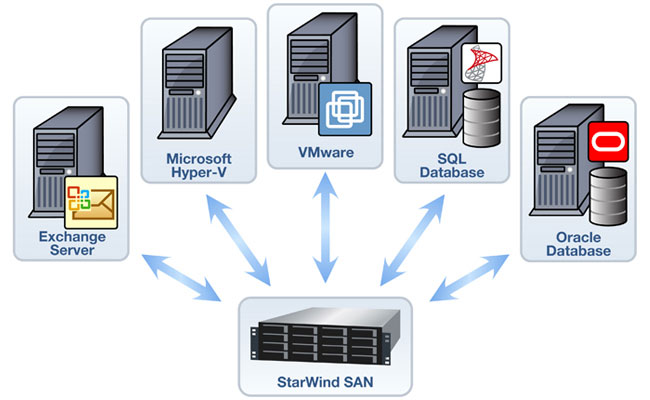1. SMB 3.0
SMB 3.0 is the crown jewel of Server 2012. It is
far removed from its laughingstock predecessor
CIFS.
It supports multiple simultaneous network interfaces – including the
ability to hot-plug new interfaces on the fly to increase bandwidth for
large or complex transfers – and supports MPIO, thin provisioning of
volumes and deduplication (assuming the underlying storage is NTFS).
SMB
3.0 also supports SMB Direct and remote direct memory access, the
ability for appropriately kitted systems to move SMB data directly from
one system's memory to the other, bypassing the SMB stack. This has
enabled Microsoft to hit 16GBps transfer rates for SMB 3.0, a weighty
gauntlet for any potential challenger to raise.
I have found
Server 2012 to be worth the cost of the upgrade, even where I have the
excellent Server 2008 R2 deployed. Given that I work with very limited
IT budgets, that is a strong endorsement.
2.
NFS 4.1
Microsoft's NFS 4.1 server is good
code. Designed from the ground up it is is fast, stable and reliable. It makes
a great storage system for heterogenous environments and a wonderful network
storage point for VMware servers.
3.
iSCSI
With Windows Storage Server 2008,
Microsoft first made an iSCSI target available. It eventually became an
optional download from Microsoft's website for Server 2008 R2 and is now
finally integrated into Server 2012 as a core
component.
4.
Hyper-V Replica
Hyper-V Replica is a storage technology designed
to continuously replicate your virtual machines across to a backup cluster. It
ensures that snapshots no more than 15 minutes old of your critical virtual
machines are available over any network link, including the internet.
It replicates the initial snapshot
in full – after that it sends only change blocks – and it fully supports
versioning of your virtual machines.
5.
Hyper-V 3.0
Server 2012 sees Hyper-V catch up
with VMware's mainstream. While objectively I would have to say that VMware
retains the feature lead at the top end, when combined with System Center 2012,
Hyper-V 3.0 will cheerfully
handle two-sigma worth of use cases.
Microsoft is no longer an also-ran
in the virtualisation space; it is a capable and voracious predator stalking
the wilds of the data centre for new prey.
Microsoft's Hyper-V Server – a free
Windows Core version of Hyper-V – is feature complete. If you have a yen to
dive into PowerShell then you can run a complete 64-node, 8,000 virtual machine
Hyper-V cluster without paying Microsoft a dime.
Microsoft's focus on PowerShell and
its decision to put price pressure on VMware with Hyper-V server has opened up
a market for third-party management tools such as 5Nine. These are not nearly as capable as System
Center, but offer a great mid-point between free and impossible to manage and
awesome but too expensive. This emerging ecosystem should see Hyper-V's market
share explode.
6.
Deduplication
For years now, storage demand has been
growing faster than hard drive density. Meeting
our voracious appetite for data storage has meant more and more spindles, and
more controllers, chassis, power supplies, electricity and cooling to keep
those spindles spinning.
7.
Cluster Shared Volumes
With Server 2012 Cluster Shared Volumes are
officially supported for use beyond hosting virtual hard disks for Hyper-V. You
may now roll your own highly available multi-node replicated storage cluster
and do so with a proper fistful of best-practice documentation.
8.
DirectAccess
DirectAccess was a neat idea but it was poorly
implemented in previous versions of Windows. Server 2012 makes it easier to
use, with SSL as the default configuration and IPSec as an option. The rigid
dependence on IPv6 has also been removed.
DirectAccess has evolved into a
reasonable, reliable and easy-to-use replacement for virtual private networks.
9.
PowerShell
PowerShell 3.0 is an evolution rather than a
revolution. Having more PowerShell scriptlets is not normally something I would
care about. That said, the 2012 line of products marks a revolution in
Microsoft's approach to server management.
Every element of the operating
system and virtually every other companion server, such as SQL, Exchange or
Lync, are completely manageable through PowerShell. This is so ingrained that
the GUIs are just buttons that call PowerShell scripts underneath.
PowerShell should be tops on this
list but to make proper use of it, your Google-fu has to be strong. The
official documentation is incomplete, Bing is still worthless for searching
Microsoft's web estate and the golden examples for making use of PowerShell lie
in the blogs maintained by Microsoft's staff.
Once you have assembled the list of
scriptlets you need – printed, laminated and guarded by a fire elemental as in
days of old – you can make the 2012 stack of Microsoft software sing. Thanks to
PowerShell, Microsoft is ready to take on all comers at any scale.
10. IIS 8
IIS 8
brings Internet Information Services up to feature parity with the rest
of the world, and surpasses it in places. More than a decade's worth of
"you use Windows as your web server" jokes officially end here.
IIS
8 sports script precompilation, granular process throttling, SNI
support and centralised certificate management. Add in a FTP server that
finally, mercifully, doesn't suck (it even has functional login
restrictions) and IIS 8 becomes worth the cost of the operating system
on its own.





































